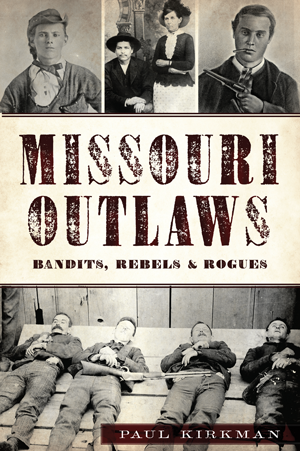

We recently sat down to read a book on Missouri true crime and were struck by the curious stories behind the jails that its most notorious outlaws landed in. So, today, we present to you a dose of history all about those curious, creepy lockups as described by Paul Kirkman in Missouri Outlaws: Bandits, Rebels, and Rogues.
Enjoy!
Jesse James. Wild Bill Hickock. Buffalo Bill Cody. The list goes on and on—as we’ve looked at before, Missouri has long been proud of its outlaw heritage, giving rise to some of the most celebrated criminals in American history. But what happens when the law finally catches up to those who have shunned it, and offers them its warmest hospitality on a cold steel bunk?

The history of Missouri’s prisons is as much a history of the state’s growth and development on the frontier as it is a tour of classic American architecture over time, writes author Paul Kirkman in his book Missouri Outlaws: Bandits, Rebels, & Rogues. Kirkman, a longtime historian in the state, takes his readers on a tour of some of Missouri’s most renowned—and unusual—‘temporary housing.’

Befitting its position on the far western edge of the new American nation, early prisons in Missouri were little more than log forts, built quickly and cheaply out of whatever local timber authorities could find. As logs could be sawn through, chiseled away at, or burned, they weren’t always the safest structures, but they had to beat one contraption found in early Johnson County: an overturned wagon bed. Kirkman:
“The first prisoners were placed inside the improvised prison under the supervision of a couple of guards. The prisoners supposedly convinced the guards to leave by offering them money to buy a gallon of whiskey for the group to share. When the sheriff came to check on the prisoners the next day, the guards were found passed out under the wagon. The prisoners were long gone.”
Frequently, he writes, the jail and the courthouse occupied the same structure, leading to raucous confrontations during and after sentencing. Over time, as new building materials began to work their way west, these crude jails gave way to more secure enclosures made of stone and brick. Resistant to fire, suitable for mounting iron chains or bars, these newer structures—often called ‘calabooses’—resisted escape much more effectively. They could also house a drunk tank, Kirkman writes, or separate facilities for women and younger offenders—or, if they were two stories high, a gallows.

But with new architecture came new innovations. As cities grew, and greater numbers began to enter the prison system at one time, law enforcement began to adopt creative means of housing their ‘guests.’ Most famous were the squirrel cages, such as the one in Gallatin which Kirkman describes:
“The entire cell block is made up of eight pie-shaped cells that sit on a single axis that could be turned using a crank. With only one cell door facing the entrance door and the rest facing solid walls, only the prisoners in one cell could enter or leave at a time. There was also a grub hole to pass food through, so even the one cell facing the entrance didn’t have to be opened. Each section has steel bunk beds and a bathroom at the narrow end of the cell. Just eighteen rotating jails were built, and only three remain.”

But the crème de la crème? The Missouri State Penitentiary, originally built in 1838 and expanded in 1868, which looks more like a medieval chateau than a reformatory institution. Allegedly one of the bloodiest, most violent, and uncontrollable institutions in American correctional history, the MSP closed in 2004—only to reopen as a tourist destination shortly thereafter. With former guests such as Pretty Boy Floyd and James Earl Ray, it’s no wonder that visitors flock to the site. But be careful not to take home any souvenirs you didn’t purchase—lest you become a guest yourself!





